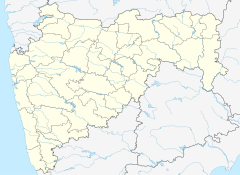Aundha Nagnath Temple
| Aundha Nagnath Temple | |
|---|---|
 |
|
|
Location in Maharashtra
|
|
| Name | |
| Other names | औंढा नागनाथ जोतिर्लिंग |
| Proper name | Aundha Nagnath Temple |
| Devanagari | औंढा नागनाथ |
| Marathi | औंढा नागनाथ |
| Geography | |
| Coordinates | 19°32′14″N 77°02′29″E / 19.537087°N 77.041508°ECoordinates: 19°32′14″N 77°02′29″E / 19.537087°N 77.041508°E |
| Country | India |
| State | Maharashtra |
| District | Hingoli |
| Locale | Aundha Nagnath |
| Culture | |
| Primary deity | Shiva |
| Important festivals | Mahashivratri |
| Architecture | |
| Architectural styles | Hemadpanthi |
Aundha Nagnath Temple (Marathi औंढा नागनाथेश्वर देउळ) is an ancient Shiva temple, considered to be one of the Jyotirlinga, located at Aundha Nagnath in Hingoli district of Maharashtra, India.
.
Aundha Nagnath is supposed to be the eighth of the twelve jyotirlingas in India, an important place of pilgrimage. The present temple is said to have been built by the Seuna (Yadava) dynasty and dates to 13th century. The first temple is said to be from time of the Mahabharata and is believed to have been constructed by Yudhishthira, eldest of the Pandavas, when they were expelled for 14 years from Hastinapur. It has been stated that this temple building was of seven-storyed before it was sacked by Aurangzeb.
Today, however, the Sanctum Sanctorum, which is located below the ground level accessed by two deep steps is infested by Pandits. The narrow chamber offers little space for the devotees to worship, added to which constant pestering by rude pandits for favors allow little space or peace of mind for offering ones personal prayers.
The temple covers an area of 669.60 sq mt (7200 sq ft) and height of 18.29 m (60 ft) The total area in which temple campus is spread is about 60,000 sq. ft. Apart from the religious significance, the temple itself is worth seeing for its unbelievably beautiful carvings. The base of the present temple is in Hemadpanti architecture although its upper portion was repaired during later period and is in the style which was prevalent during the Peshwa's regime.
The temple is also closely associated with lives of Namdev, Visoba Khechara and Jñāneśvar, the sants revered by the Varkari sect of Hinduism.
...
Wikipedia

